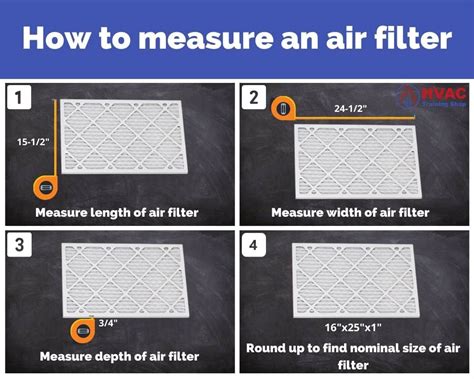Get a Perfect Fit Every Time: Air Filter Measuring
Finding the right air filter for your HVAC system is crucial for maintaining indoor air quality and the efficiency of your unit. A poorly fitting filter restricts airflow, leading to reduced heating and cooling performance, increased energy bills, and potential damage to your system. Mastering the art of air filter measuring ensures you always get the perfect fit. This guide provides a comprehensive approach to accurately measuring your air filter and selecting the correct replacement.
Why Accurate Air Filter Measurement Matters
Before diving into the measuring process, let's understand why precise measurements are so critical. An incorrectly sized filter can lead to several problems:
- Reduced Airflow: A too-small filter will restrict airflow, forcing your system to work harder and potentially overheating.
- Increased Energy Costs: The extra strain on your system translates to higher energy consumption and bills.
- System Damage: Overworking the system can lead to premature wear and tear, requiring costly repairs or replacements.
- Poor Indoor Air Quality: A poorly sealed filter allows dust, allergens, and other contaminants to bypass filtration, negatively affecting your home's air quality.
How to Measure Your Air Filter: A Step-by-Step Guide
Measuring your air filter is surprisingly simple, but accuracy is paramount. Follow these steps:
-
Access the Filter: Locate your HVAC system's air filter. It's usually found in a readily accessible compartment, often located on the side or top of the unit. Consult your system's manual if you're unsure of its location.
-
Remove the Old Filter: Carefully remove the old air filter. Take note of the direction of airflow (often indicated by arrows on the filter frame). This will be crucial when installing the new filter.
-
Measure the Dimensions: Use a ruler or measuring tape to precisely measure the filter's length and width. Record these measurements in inches. Don't rely on memory; write them down! Many filters are not perfectly square or rectangular, so careful attention to detail is essential.
-
Consider Depth/Thickness: While length and width are crucial, don't forget the filter's depth (thickness). This measurement, also in inches, ensures the new filter fits snugly within the housing. Some systems accommodate a range of filter thicknesses, so checking this dimension is equally important.
-
Record Your Findings: Write down all three measurements (length, width, and depth) in inches. Keep this information handy when purchasing a replacement. Taking a photo of the old filter and its dimensions can also be helpful.
Understanding Air Filter Size Terminology
Air filter sizes are typically expressed as a combination of length, width, and depth (e.g., 16x25x1). Understanding this notation ensures you find the correct replacement. Sometimes, you might encounter variations in how the dimensions are listed, so paying close attention to the manufacturer’s specifications is vital.
What if I can't find my old filter?
If you can’t locate the old filter, don't panic! Check the manufacturer's information for your HVAC system – the manual will list the recommended filter size.
Beyond the Measurements: Choosing the Right Filter Type
While accurate measurements are crucial, selecting the correct filter type is equally important. Consider these factors:
- MERV Rating: The Minimum Efficiency Reporting Value (MERV) rating indicates the filter's efficiency in trapping particles. Higher MERV ratings indicate greater efficiency but can also restrict airflow.
- Filter Material: Different materials (e.g., pleated, fiberglass, HEPA) offer varying levels of filtration and durability.
- Your Needs: Consider your family's needs and sensitivities. If you have allergies or asthma, a higher MERV rating filter might be beneficial.
Troubleshooting Common Air Filter Measurement Issues
-
The new filter is too big: This usually means an inaccurate measurement. Double-check your measurements and verify the filter size matches the specifications from your HVAC system's manual.
-
The new filter is too small: This can lead to poor airflow and system inefficiencies. Recheck your measurements and ensure you're using the correct filter type.
-
The filter doesn't fit snugly: Ensure that you're using a filter designed for your specific HVAC system. A loose fit can compromise filtration efficiency.
By following these steps and understanding the importance of accurate measurement, you can ensure your HVAC system always operates at peak performance with the perfect air filter. Remember, regular filter replacement is essential for maintaining healthy indoor air quality and extending the lifespan of your HVAC system.

